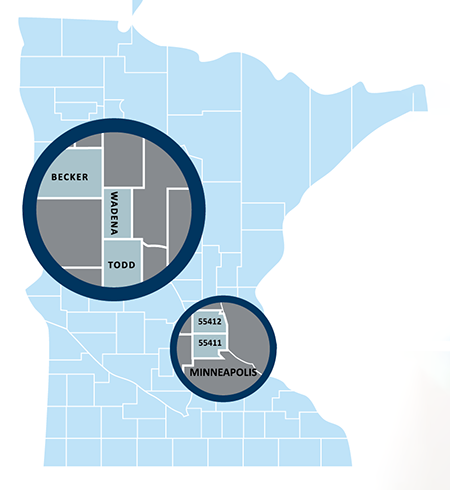Biomonitoring
- Biomonitoring Home
- About Biomonitoring
- Biomonitoring Projects
- Biomonitoring Reports
- Advisory Panel
- Biomonitoring and Tracking Legislation
Related Sites
Environmental Health Division
Contact Info
Healthy Rural and Urban Kids
For the project’s background and all findings, read the full
Community Report:
Healthy Rural and Urban Kids Community Report (PDF), English
Healthy Rural and Urban Kids Community Report (PDF), Somali
Healthy Rural and Urban Kids Community Report (PDF), Spanish
Healthy Rural and Urban Kids Community Report (PDF), Hmong
About the project
The Healthy Rural and Urban Kids Project measured chemicals in preschool-aged children living in Minnesota rural and urban communities in the summer of 2018.

Kids were from these areas:
- Neighborhoods in North Minneapolis - zip codes 55411 and 55412 - with community concerns about air pollution and other environmental issues.
- Counties in North-Central Minnesota - Becker, Todd and Wadena - with community concerns about pesticides and chemicals in private well water.
We worked in these communities with exposure concerns because we do not have baseline information about Minnesota kids’ exposures to chemicals. Comparing kids in these areas, along with looking at kids overall, is one way to identify unusual exposures and find opportunities to prevent chemicals getting into kids’ bodies.
MDH partnered with Minneapolis Public Schools and Becker, Todd, and Wadena Counties to offer participation to kids coming in for their routine Early Childhood Screening (ECS) visit. ECS is a required screening for all Minnesota kids before they enter kindergarten. The 232 families who gave consent for their child to participate completed a short survey and helped their child collect a urine sample. Urine samples were analyzed for 21 different chemicals that tell us about exposure to air pollution, metals, and pesticides.
What we learned
Chemicals were commonly found in kids in this project. Each of the 21 chemicals were detected in at least one child. The chemicals were generally at lower or similar levels than the U.S. average for kids in this age range.
- Kids from the urban area had higher urine levels of air pollution chemicals compared to rural kids and the U.S. average in kids. For one of these chemicals, we saw a link between using incense in the home and urine levels. Kids who drove with a smoker had higher urine levels of another. These chemicals are part of a large class of chemicals made during combustion called polycyclic aromatic hydrocarbons, or PAHs.
- Kids from the rural area had higher urine levels of one pesticide (2,4-D) compared to urban kids. We saw a link between living closer to corn and other types of agricultural fields and urine 2,4-D levels. 2,4-D is an herbicide used on agricultural crops and for lawn treatment.
We learned about potential ways Minnesota kids may be coming in contact with the chemicals. These results point to equity issues that are important to address.
- Kids who ate rice frequently had urine arsenic levels that were twice as high as kids who did not eat rice. Asian kids were more likely to eat rice frequently and have higher urine arsenic levels.
- Kids from the urban area whose family used a pesticide in the home recently had urine levels of one pesticide chemical (3PBA) that were three times as high as kids whose family did not use a home pesticide. 3PBA shows exposure to synthetic pyrethroid insecticides used in home pesticide sprays, bug bombs, mosquito sprays, and farming. Urban kids were more likely to rent their homes; they may live with inadequate home maintenance and not have control over use of pesticides in their homes.
- The link between using incense in the home and higher urine levels of one air pollution chemical has not been reported before to our knowledge. Black/African American kids were more likely to use incense frequently and have higher urine levels of this chemical.
These results tell us that exposures may be higher in some groups of Minnesota kids compared to others. This helps us work with families and partners to learn more and find ways to prevent exposures. The results do not tell us what levels of exposure may impact a child’s health.
While this project is relatively small, it led to new funding for MDH to expand this work and involve more kids and chemicals in a statewide approach in our new program, Healthy Kids Minnesota.
For more information
For more information on the chemicals included and ways to reduce child exposure, view the Healthy Rural and Urban Kids Translated Information Sheets (Hmong, Somali, Spanish and English).
Read the Healthy Kids 2018 Survey (PDF).
Contact MN Biomonitoring health.biomonitoring@state.mn.us.
Related links
Minnesota Chemicals of High Concern to Children's Health